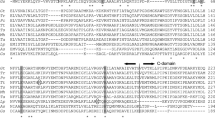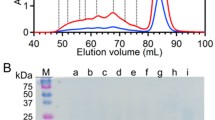Abstract
Analysis of the protein structure of bovine liver catalase suggested that the N-terminal region containing two α-helices may function as a linker binding to another subunit. The number of amino-acid residues in catalase from the n-alkane-assimilating yeast Candida tropicalis (CTC) is the lowest of any eukaryotic catalase molecule hitherto investigated, and only one helix, corresponding to the helix α2 in bovine liver catalase, is estimated to be present in the same region. In the present study, N-terminal-deleted mutants of CTC were characterized to evaluate the role of the α-helix structure in the N-terminal region. CTCΔ1–4 and CTCΔ1–24, whose N-terminal regions were shortened by four and 24 amino-acid residues, respectively, showed an 80% decrease in specific activity compared to wild-type CTC in spite of containing the same amount of heme as in the wild-type. Polyacrylamide gel electrophoresis under nondenaturing conditions revealed that the mutants contained large amounts of oligomeric forms with molecular masses less than 220 kDa (tetramer assembly). Although the smaller oligomers were found to be bound with heme, only the tetramer exhibited catalase activity in activity staining on nondenaturing gel. CTCΔ1–49, a mutant with deletion of the N-terminal 49 amino-acid residues which contain the conserved helix α2, showed no catalase activity and no heme binding. However, the CD spectrum profiles of CTCΔ1–49, CTCΔ1–4, and CTCΔ1–24 indicated that these mutant subunits could attain secondary conformations similar to that of wild-type CTC, regardless of their binding with heme. From these results, it was concluded that the N-terminal stretch of catalase is significant for complete assembly into active tetramer and that the conserved helix α2, although it has little effect on the formation of the subunit secondary structure, is indispensable not only in assembling tetramer but also in binding heme.




Similar content being viewed by others
References
Bell GI, Najarian RC, Mullenbach GT, Hallewell RA (1986) cDNA sequence coding for human kidney catalase. Nucleic Acid Res 14:5561–5562
Clos J, Westwood JT, Becker PB, Wilson S, Lambert K, Wu C (1990) Molecular cloning and expression of a hexameric Drosophila heat shock factor subject to negative regulation. Cell 63:1085–1097
Fita I, Rossmann MG (1985) The active center of catalase. J Mol Biol 185:21–37
Fita I, Murthy MRN, Rossmann MG (1986) Comparison of beef liver and Penicillium vitale catalases. J Mol Biol 188:63–72
Furuta S, Hayashi H, Hijikata M, Miyazawa S, Osumi T, Hashimoto T (1986) Complete nucleotide sequence of cDNA and deduced amino acid sequence of rat liver catalase. Proc Natl Acad Sci USA 83:313–317
Hartig A, Ruis H (1986) Nucleotide sequence of the Saccharomyces cerevisiae CTT1 gene and deduced amino-acid sequence of yeast catalase T. Eur J Biochem 160:487–490
Kanai T, Atomi H, Umemura K, Ueno H, Teranishi Y, Ueda M, Tanaka A (1996) A novel heterologous gene expression system in Saccharomyces cerevisiae using the isocitrate lyase promoter from Candida tropicalis. Appl Microbiol Biotechnol 44:759–765
Kawamoto S, Tanaka A, Yamamura M, Teranishi Y, Fukui S, Osumi M (1977) Microbody of n-alkane-grown yeast. Enzyme localization in the isolated microbody. Arch Microbiol 112:1–8
Kinoshita H, Atomi H, Ueda M, Tanaka A (1994) Characterization of the catalase of the n-alkane-utilizing yeast Candida tropicalis functionally expressed in Saccharomyces cerevisiae. Appl Microbiol Biotechnol 40:682–686
Kinoshita H, Ueda M, Atomi H, Hashimoto N, Kobayashi K, Yoshida T, Kamasawa N, Osumi M, Tanaka A (1998) Expression and subcellular localization of Candida tropicalis catalase in catalase gene disruptants of Saccharomyces cerevisiae. J Ferment Bioeng 85:571–578
Murshudov GN, Melik-Adamyan WR, Grebenko AI, Barynin VV, Vagin AA, Vainshtein BK, Dauter Z, Wilson KS (1992) Three-dimensional structure of catalase from Micrococcus lysodeikticus at 1.5 Å resolution. FEBS Lett 312:127–131
Musthy MRN, Reid III TJ, Sicignano A, Tanaka N, Rossmann MG (1981) Structure of beef liver catalase. J Mol Biol 152:465–499
Okada H, Ueda M, Sugaya T, Atomi H, Mozaffar S, Hishida T, Teranishi Y, Okazaki K, Takechi T, Kamiryo T, Tanaka A (1987) Catalase gene of the yeast Candida tropicalis - Sequence analysis and comparison with peroxisomal and cytosolic catalases from other sources. Eur J Biochem 170:105–110
Quan F, Korneluk RG, Tropak MB, Gravel RA (1986) Isolation and characterization of the humen catalase gene. Nucleic Acid Res 14:5321–5335
Sikorski AS, Hieter P (1989) A system of shuttle vectors and yeast host strains designed for efficient manipulation of DNA in Saccharomyces cerevisiae. Genetics 122:19–27
Soga O, Kinoshita H, Ueda M, Tanaka A (1997) Evaluation of peroxisomal heme in yeast. J Biochem 121:25–28
Vainshtein BK, Melik-Adamyan WR, Barynin VV, Vagin AA, Grebenko AI, Borisiv VV (1986) Three-dimensional structure of catalase from Penisillium vitale at 2.0 Å resolution. J Mol Biol 188:49–61
Yamada T, Tanaka A, Horikawa S, Numa S, Fukui S (1982) Cell-free translation and regulation of Candida tropicalis catalase messenger RNA. Eur J Biochem 129:251–255
Author information
Authors and Affiliations
Corresponding author
Rights and permissions
About this article
Cite this article
Ueda, M., Kinoshita, H., Maeda, SI. et al. Structure-function study of the amino-terminal stretch of the catalase subunit molecule in oligomerization, heme binding, and activity expression. Appl Microbiol Biotechnol 61, 488–494 (2003). https://doi.org/10.1007/s00253-003-1251-5
Received:
Revised:
Accepted:
Published:
Issue Date:
DOI: https://doi.org/10.1007/s00253-003-1251-5




